WAGNER and his STUDENTS MAY/JUNE 2025
ENTRANCE HALL
1 Gerard Wagner 1906-1999, The threatened Earth
2 Gerard Wagner, Behold!
3 Gerard Wagner, The Epidemic
4 Gwenola Hemlin, St Christopher carries the Christ Child
5 Karin Joos, Corona
6 Karin Joos, Easter
7 Karin Joos, At Sunset
8 Karin Joos, Autumn’s Harvest
Drawings:
9 Robert Wroblewski, Light and Shadow,
10 Simone Huguenin, Moonlight and Storm
11 Van James, All Hallows Eve
12 Robert Wroblewski, Soul Space 1
13 Alexander Winter 1951-2019, Plant Metamorphosis, 12 prints
14 Robert Wroblewski, Soul Space 2
15 Ingrid Marl, 13 Angels – Companions on a Pilgrimage, pastel (In the showcase)
GALLERY
16 Bernd Lutz, 6 paintings from a series of 19:
The Representative of Humanity to the Threefold Human Being
17 Gwenola Hemlin, Trees by a Waterfall
18 Gwenola Hemlin, Trees by a Waterfall,
19, 20, 21 Maria Keller (1910-2012), 3 Paintings: Baptism -Golgotha Imagination-Meeting
with the Etheric Christ
22 Katherine Rudolph, Archetypal Plant
23 Elisabeth Wagner-Koch (1923-2022), Rose Cross
24, 25 ,26 Simone Huguenin, Soul Calender verses: 8th, 21st, and 29th Weeks
24 26 May – 1 June
The senses‘ might grows strong
United with the Gods‘ creation.
It dulls my power of thought
To vague unconsciousness of dream.
When godlike being
Would seek a union with my soul
Must human thinking, in quiet dream-state, rest contented.
25 25 -31 August
I feel a strange power bearing fruit
Granting inner strength.
I sense the seed maturing,
And sensing light-filled weaving
Gives power of self to me.
26 20 – 26 October
Oneself the light of thinking
Kindled powerfully within,
Interpreting existence,
From cosmic spirit’s source of strength –
This is for me summer’s bequest,
Is autumn’s calm and also winter’s hope.
27 Maria Keller, Colour creates the Human Being
28 Van James, Three Watercolours/ art cards
29 Ivo Rebic, Christmas Mood
30 Caroline Chanter, Krishna and Radha
31 Caroline Chanter, Humankind
32 Caroline Chanter, Threshold Experience
33 Katherine Rudolph, A Hut in a Storm with Lightning
34 Katherine Rudolph, Johannes Thomasius between Lucifer und Ahriman
35 Erwin Thomalla (1925-1983), Christ carries the Earth
36 Erwin Thomalla, Maria Imagination
Drawings:
37 Simone Huguenin, The three Norns (goddesses) water the cosmic Ash ‘Yggdrasil ‘with
the waters of life.
38 Simone Huguenin, Light and Shadow
39 Simone Huguenin, Elemental Beings
During term time and often during vacations there is an exhibition of paintings in our gallery on the ground floor.
Opening times:
1pm to 5pm, Monday to Sunday
The painting studio is on the first floor. Feel free to visit us and take a look at the student’s work.
WAGNER AND HIS STUDENTS
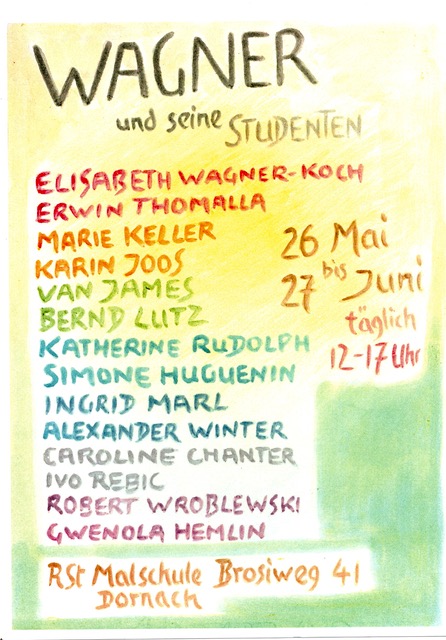
Paintings by Karin Joos
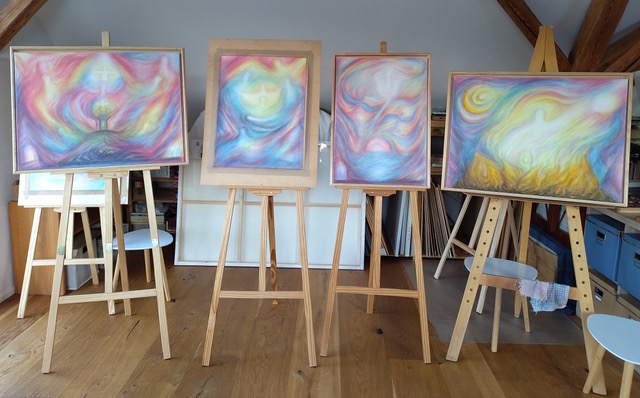
Previous Exhibitions:

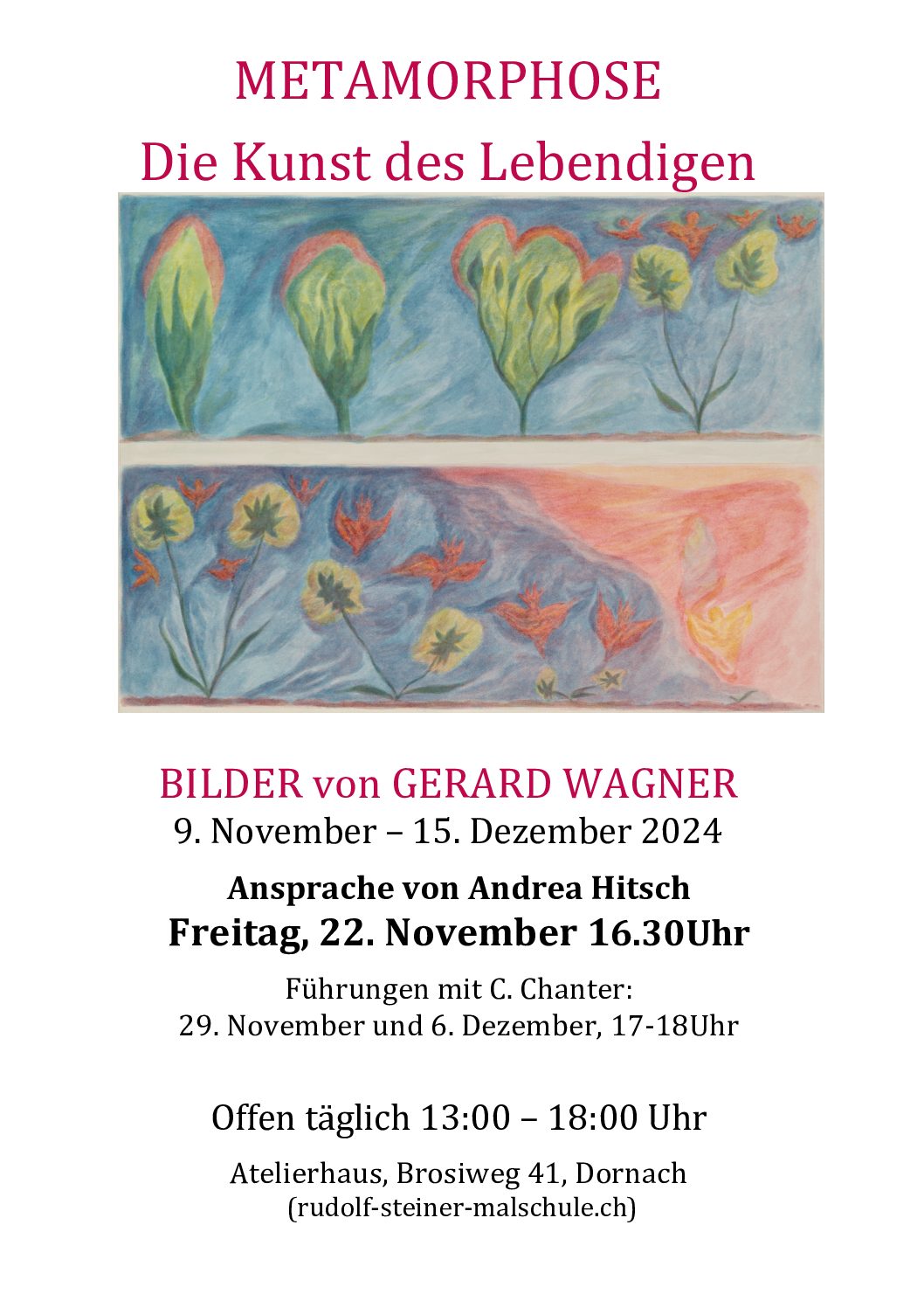
Exhibition: Metamorphosis – the Art of the Living
The Painter as Researcher
Among the broad expanse of Gerard Wagner’s painterly oeuvres the subject of metamorphosis holds a special place. From the early days of his life in Dornach (from 1926), his search to discover how form arises out of colour led him ever further into the realm of the living world and to metamorphosis.
His research opened up true spiritual scientific revelations. This was possible essentially for two reasons. Firstly, Wagner based all his colour research and understanding of colour on Rudolf Steiner’s indications which gave him a sure foundation. And secondly, he gave his artistic colour experimentation a methodical scientific character which enabled him, by way of an awakened feeling capacity, and through repeated experimentation, to confirm the results of his research. One can find a motto for his approach in the book The Philosophy of Spiritual Activity by Rudolf Steiner: ‘Seelische Beobachtungsresultate nach Naturwissenschaftlicher Methode’.
We know about Goethe’s discoveries in the direction of metamorphosis and how these inspired Rudolf Steiner. We see the metamorphosis in art mainly in the architecture and sculptural forms of the Goetheanum buildings. 25 years after the death of Gerard Wagner and a hundred years after Rudolf Steiner created the paintings and sketches on which Wagner based his work, it might be a good time to recognise that metamorphosis in painting has found its place in the anthroposophical movement through the spiritual scientific research of a painter.
In the Atelierhaus Gallery at Brosiweg 41, Dornach (the home of the Rudolf Steiner Painting School) over 30 paintings are on show until the 15.Dezember. One sees in the paintings of the 1960s, usually eight small pictures within one painting, sequences of pictures which have their beginning in a motif sketch – Archetypal Plant or Archetypal Animal-Human Being – painted by Rudolf Steiner. Other sequences show transformations which begin with one of the Nature Mood motifs sketched by Rudolf Steiner for Henni Geck’s painting school at the Goetheanum. This is a revelation in itself, but Wagner didn’t stop there; he delved further and discovered that these Nature Motif sketches can lead to some remarkable unexpected
motifs which take the observer into unknown realms of colour and form.
The later works of the 1980s and 1990s painted with plant pigments include two outstanding paintings, one of the Archetypal Plant, the other of the Archetypal Animal-Human Being which were exhibited at the Hermitage, St Petersburg, Russia in November 1997.
Andrea Hitsch will give a talk on Friday 22. November at 16.30 Uhr in the Gallery, and Caroline Chanter will give a tour of the exhibition between 17-18Uhr on Friday 29 November and 6 December.
Opening times: 13 – 18 Uhr daily.


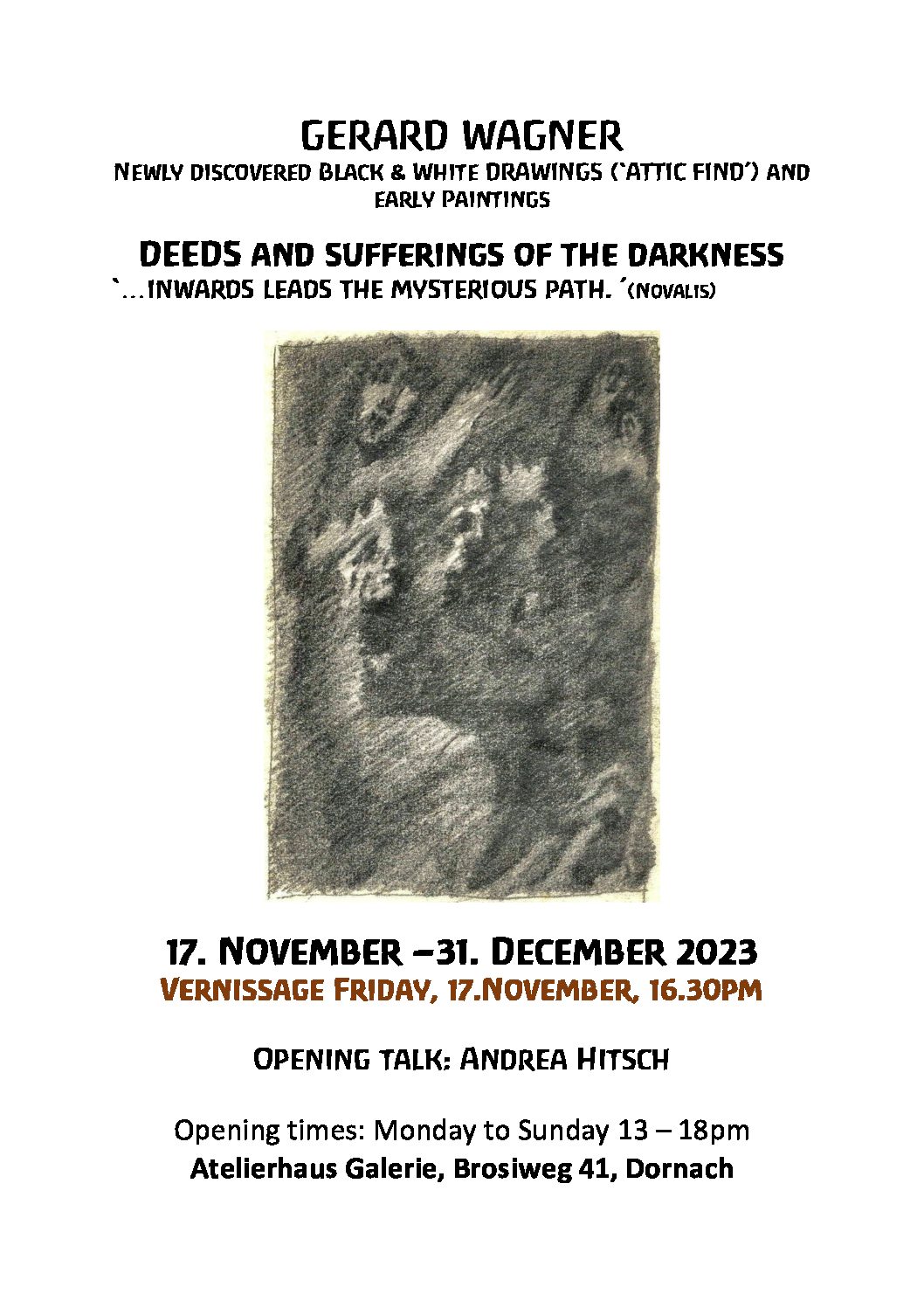
Our new exhibition shows 21 small mysterious black and white drawings by Gerard Wagner which were found recently in the attic of his home and never previously exhibited, let alone seen. Early paintings from the same period (late 1930s/1940s) accompany the drawings.
In the entrance hall are paintings by Gerard Wagner of the Mystery Play ‘Curtain-motif,’ originally sketched by Rudolf Steiner in 1914. And in the showcase are dynamic and fascinating drawings by Andrea Hitsch, which appear as illustrations in three books by Gunter Aschoff: Das Hohelied Salomos, Briefe von dem Jakobus und Das Markus-Evangelium. (The Song of Solomon, Letters of James and The Gospel of St Mark) The exhibition will also be open during the Christmas Conference at the Goetheanum from 26 to 31 December 2023.

Exhibition of Cupola Motifs by Gerard Wagner, 17 February – 4 June 2023
The Large Cupola motifs were painted by Gerard Wagner in 1995 as part of the preparation for the renovation of the Goetheanum Auditorium. Exciting painting workshops led by Christian Hitsch, Walter Roggenkamp and Gerard Wagner were part of the preparation which focused on the original sketches of Rudolf Steiner’s, originally given as guidance to the artists who painted the ceiling of the First Goetheanum.
The renovation project of the second Goetheanum stimulated Wagner to turn once again to the Cupola motifs with which he had been familiar with for years. A particular interest of his was how the separate motifs could be woven together on the different background colours of the rainbow, as indicated by Rudolf Steiner. A few models of the second Goetheanum ceiling show Wagner’s attempt at uniting all the Large Cupola motifs in a living organism of colour.
‘The Representative of Humanity’ 8 October – 4 December 2022
The motif of the ‘Representative of Humanity’ was the artistic and spiritual focus of the first Goetheanum building destroyed by fire on New Years Eve 1922/23. The sculpture, created by Rudolf Steiner and Edith Maryon, was to be placed at the back of the stage under the painted version of the same motif visible on the domed ceiling above. The sculpture carved in Elmwood shows the figure of the Representative of Humanity holding the balance between Lucifer and Ahriman. Steiner made an addition to the original design of the three figures by adding two further images of Lucifer and Ahriman, almost intertwined, to the right of the central figure. The ‘Rock Being’ at the top of the sculpture was added later to harmonise the balance between the figures.
Rudolf Steiner also drew a coloured sketch of the motif which he eventually painted on the small cupola ceiling himself. Here the dynamic language of form visible in the sculpture is transformed into a dynamic language of colour. The central figure is painted in golden yellow; light rays extend from his right hand towards the form of Ahriman in his cave below. His left hand reaches up to the red figure of Lucifer soaring above. Images of the sun and moon are included: a small moon near the figure of Lucifer, a mighty ray of light directed down towards the figure of Ahriman. The Mystery of Golgotha is represented by three crosses standing on a dark mound of earth surrounded by darkness. Balance as the theme of the motif is also shown here as balance of colour: the living, active nature of red and yellow in the sphere of levity above is balanced by the deadness of black (the spiritual image of death) below where gravity holds sway. The purity of the central figure –the Christ– who holds the opposing powers in balance through love, is expressed in yellow, the shine of the spirit. The surrounding blue (the lustre of the soul) calls forth the nurturing forces of the heavenly cosmic powers.
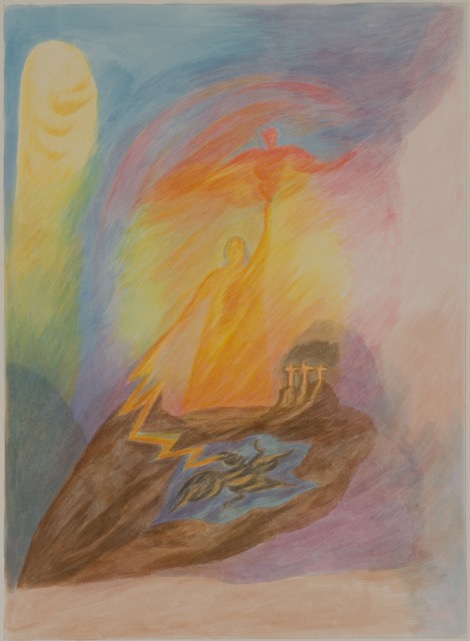
As the centenary of the burning of the Goetheanum approaches, one can look to this motif as the expression of every striving person who is searching for balance out of the forces of an awakening heart – as the true mission of anthroposophy.
To celebrate this motif, made visible in artistic form by Rudolf Steiner, the Rudolf Steiner Painting School and the Gerard and Elisabeth Wagner-Verein are staging an exhibition of 22 pictures of the ‘Representative of Humanity’ painted by Gerard Wagner.
The opening is on Friday, 7 October 2022 at 5pm: Address by Andrea Hitsch; music improvised by Johanna Lamprecht. The exhibition closes on the 4 th December.
Atelierhaus, Brosiweg 41,4143 Dornach. Opening times: 1pm to 6pm, Monday to Sunday. (rudolf-steiner-malschule.ch)
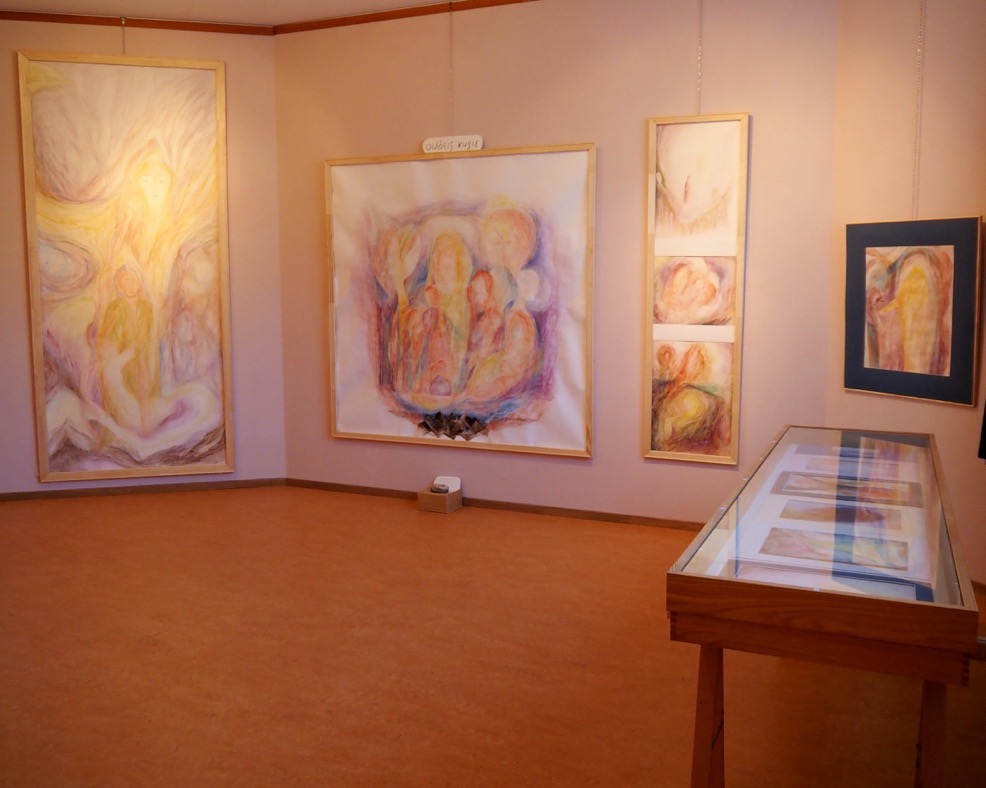
The exhibition in the painting school at Brosiweg in Dornach showed 33 paintings by Frank Spaan from about 25 years. Mainly, but not only, he worked with vegetable watercolours on paper. The size varies from 20×20 cm to 4 m2.
“How do I paint in the 21st century?” was and is a central question. The artistic process investigates how the spirit of the theme of the painting can enter into the substance of the artwork; which conditions, in material and method – based on Rudolf Steiner, Margarita Woloschin and autodidactic development – support this connection.
The exhibition lasted until 19 June.
ERWIN THOMALLA (1925-1983)
24 October 2021 until 27 February 2022
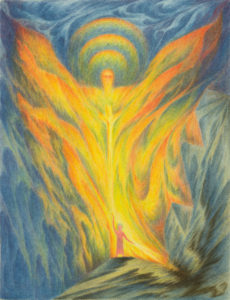

 English
English